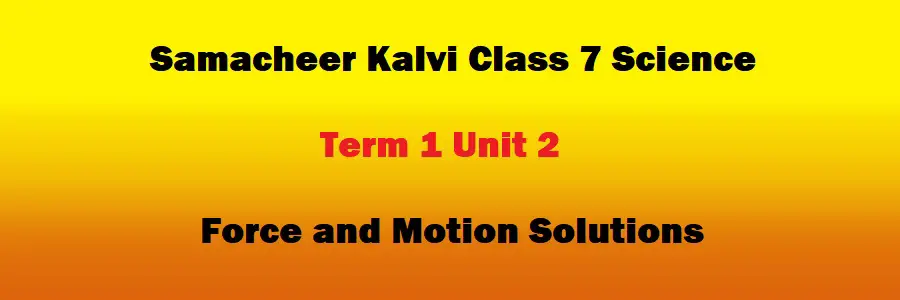Samacheer Kalvi Class 7 Science Term 1 Unit 2 Force and Motion Solutions
Welcome to NCTB Solutions. Here with this post we are going to help 7th class students by providing Solutions for Samacheer Kalvi Class 7 Science Term 1 Unit 2 Force and Motion. Here students can easily find all the solutions for Force and Motion Exercise questions. Also here our Expert Science Teacher’s solved all the questions with easily understandable language with proper guidance so that all the students can understand easily. Here on this post students will get Unit 2 exercise solutions. Here all the solutions are based on Tamil Nadu State Board latest syllabus.

Unit 2 Force and Motion Exercise Questions Solutions :
(I) Choose the best answer.
(1) A particle is moving in a circular path of radius r. The displacement after half a circle would be
(a) Zero
(b) R
(c) 2 r
(d) r/2
Answer :
Correct option → (c)
The displacement after half a circle would be 2r
(4) From the given v-t graph it can be inferred that an object is
(a) in uniform motion
(b) at rest
(c) in non – uniform motion
(d) moving with uniform accelerations
Answer :
The answer → (c)
That an object is in non-uniform motion
(II) Fill in the blanks.
(1) The shortest distance between two places is __.
(2) The rate of change of velocity is __.
(3) If the velocity of an object increases with respect to time, then the object is said to be in __ acceleration.
(4) The slope of the speed–time graph gives __.
(5) In __ equilibrium, the centre of gravity remains at the same height when it is displaced.
Answer :
(1) → Displacement
(2) → Acceleration
(3) → Positive
(4) → Velocity
(5) → Neutral
(III) Match the following :
| Displacement | Knot |
| Light travels through vacuum | Geometric centre |
| Speed of ship | Metre |
| Centre of gravity of the geometrical shaped object | Larger base area |
| Stability | Uniform velocity |
Answer :
Displacement → meter
Light travels through vacuum → uniform velocity
Speed of ship → knot
Centre of gravity of the geometrical shaped object → larger base area.
Stability → Geometric centre.
(IV) Analogy :
(1) Velocity : metre / second :: Acceleration : ___.
Answer :
Velocity : metre/ second : : acceleration : metre /second2
(2) Length of scale : metre :: Speed of aeroplane : ___.
Answer :
length of scale : metre : : speed of aeroplane : knot
(3) Displacement / Time : Velocity :: Speed / Time : ___.
Answer :
Displacement / time : velocity : : speed / time : acceleration
(VI) Answer briefly.
(2) Distinguish between speed and velocity.
Answer :
- Speed :
(i) It is distance travelled by an object in unit time.
(ii) It is scalar quantity
(iii) Speed = Distance travelled/time taken.
- Velocity :
(i) It is the distance travelled by an object in unit time in a given direction.
(ii) It is a vector quantity.
(iii) Velocity = Displacement/time taken
(3) What do you mean by constant acceleration?
Answer :
If a body travels a straight line and its velocity increases or decreases by equal magnitude in equal interval of time.
(4) What is centre of gravity?
Answer :
It is the point through which the entire weight of the object appears to act.
(VII) Answer in detail.
(1) Explain the types of stability with suitable examples.
Answer :
There are three types of stability,
(a) Stable equilibrium : It is that type of equilibrium where its frustum can be tilted through quite a big angle without toppling. In this equilibrium its centre of gravity is raised when it is displaced and the vertical line is through its centre of gravity where it is still falls within its base.
(b) Unstable equilibrium : It is that type of equilibrium where its frustrum will topple with slightest tilting. In the equilibrium the centre of gravity is lowered when it is displaced and its vertical line is through its centre of gravity falls outside its base.
(c) Neutral Equilibrium : It is that type of frustum which cause topple and will roll about but does not topple. In this equilibrium its centre of gravity remains at the same height when it is displaced.
(2) Write about the experiment to find the centre of gravity of the irregularly shaped plate.
Answer :
(a) At first make 3 holes in the lamina,
(b) Than, suspend the lamina from the optical pin through one of the holes,
(c) After that, the suspended the plumb line from the pin then mark the position of the plumb line on the lamina,
(d) Draw lines on the lamina representing the positions of the plumb line and repeat the above steps for the holes,
(e) In the end label the intersection of the three lines as X, the position of the centre of gravity of the lamina.
(VIII) Numerical problems.
(1) Geetha takes 15 minutes from her house to reach her school on a bicycle. If the bicycle has a speed of 2 m/s, calculate the distance between her house and the school.
Answer :
In this question we have,
Time taken = 15minutes
= 15 x 60 = 900 sec
Speed = 2 m/s
So, we have to find Distance,
Distance = Speed x time
= 2 x 900
= 1800m
(3) A bus can accelerate with an acceleration of 1 m/s2. Find the minimum time for the bus to attain the speed of 100 km/s from50 km/s.
Answer :
In this question we have,
Acceleration= 1m/s^2
Initial velocity (u) = 50km/s
= 50 x 10^3m/s
Final velocity (v) = 100km/s
= 100 x 10^3m/s
We have to find time
t = v – u/a
= 100 x 10^3 – 50 x 10^3/1
= 50 x 10^3s
Next Chapter Solution :